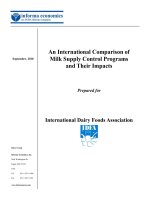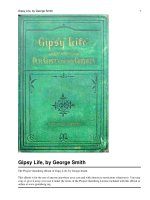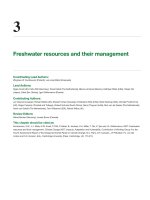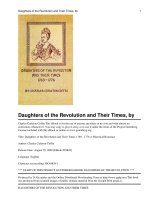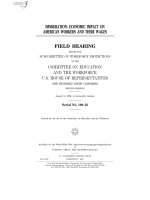- Trang chủ >>
- THPT Quốc Gia >>
- Hóa
Discovering plants, animals, and their environments
Bạn đang xem bản rút gọn của tài liệu. Xem và tải ngay bản đầy đủ của tài liệu tại đây (1.8 MB, 8 trang )
Life Sciences
Standards
Preview
Standard Set 2. Life Sciences
2. Plants and animals have
predictable life cycles. As a basis for
understanding this concept:
2.a. Students know that organisms
reproduce offspring of their own kind
and that the offspring resemble their
parents and one another.
2.c. Students know many
characteristics of an organism are
inherited from the parents. Some
characteristics are caused or influenced
by the environment.
2.d. Students know there is variation
among individuals of one kind within
a population.
by Johanna Biviano
Genre
Nonfiction
Comprehension Skill
Use Text Features
Text Features
• Captions
• Labels
• Glossary
Science Content
Living Things in
Environments
Scott Foresman Science 2.3
ISBN 0-328-23501-6
ì<(sk$m)=cdfabi< +^-Ä-U-Ä-U
Vocabulary
environment
inherit
offspring
Picture Credits
Every effort has been made to secure permission and provide appropriate credit for photographic material. The
publisher deeply regrets any omission and pledges to correct errors called to its attention in subsequent editions.
Unless otherwise acknowledged, all photographs are the copyright of Dorling Kindersley, a division of Pearson.
Photo locators denoted as follows: Top (T), Center (C), Bottom (B), Left (L), Right (R), Background (Bkgd).
Opener: (C) Natural Picture Library, Ltd.
1 Natural Picture Library, Ltd.; 3 (Bkgd) OSF/Dowling, Roberts/Animals Animals/Earth Scenes, (Inset) Mark Boulton/
Alamy Images; 4 (BL) Neil Fletcher and Matthew Ward/DK Images, (BR) Richard Shiell/Animals Animals/Earth Scenes;
7 (B) Jim Brandenburg/Minden Pictures, (T) Natural Picture Library, Ltd.; 8 Hal Horwitz/Corbis; 9 Phyllis Greenberg/
Animals Animals/Earth Scenes; 10 Larry Allan/Bruce Coleman Inc.; 11 (R) Mark Raycroft/Minden Pictures, (L) Gerard
Lacz/Peter Arnold, Inc.
ISBN: 0-328-23501-6
Copyright © Pearson Education, Inc. All Rights Reserved. Printed in the United States of America.
This publication is protected by Copyright, and permission should be obtained from the publisher prior to any
prohibited reproduction, storage in a retrieval system, or transmission in any form by any means, electronic,
mechanical, photocopying, recording, or likewise. For information regarding permission(s), write to
Permissions Department, Scott Foresman, 1900 East Lake Avenue, Glenview, Illinois 60025.
1 2 3 4 5 6 7 8 9 10 V010 13 12 11 10 09 08 07 06
by Johanna Biviano
How are offspring
like their parents?
Young plants and animals are called
offspring. Living things have offspring.
Young living things can look like their
parents. Oak trees start as acorns. Acorns
become young oak trees. Young oak trees grow
to look like adult oak trees.
Things Offspring Inherit
Offspring inherit, or get, some things from
their parents. These piglets have the same pink
skin as their mother. They have her black spots,
floppy ears, and a curly tail. The piglets look
like each other too.
How are the piglets
like the mother pig?
Acorns grow into
oak trees.
2
3
Plant Offspring
Young plants inherit things from their parents
too. Young plants often have the same color
and shape as their parents.
California Bay seedlings look like their
parents. Their leaves are the same shape. They
grow the same kind of seedpod.
California Bay seedlings
have leaves like their
parents.
4
This is a wild pea plant. The youngest wild
pea plants do not grow flowers. As they grow
bigger they will look more like their parents.
Young wild pea plants
do not look like their
parents.
5
The Environment
The environment is everything around a
living thing. The environment has air, sunlight,
water, and soil. It can change how plants grow.
Sunlight changes sunflowers. A sunflower will
turn to face sunlight. Sunflowers can grow in
cold air as well as warm air.
Sunflowers can grow in
very cool weather.
6
The environment can change how animals
grow. The Arctic fox lives in Alaska and
Canada. In the summer the fox has gray fur. In
the winter it has thick white fur. White fur helps
the Arctic fox stay safe.
Changes to the color of
its fur help the Arctic
fox stay safe.
7
Ways Plants
Can Be Different
There are many different kinds of plants.
Some plants have flowers. An orchid has
flowers. One orchid might have big and small
flowers at the same time. Some of them have
different colors or patterns.
Orchids come in many colors and shapes.
Some have big leaves. Others have small
leaves. Some orchids have many flowers.
Others have few. But they are all orchids.
Different orchids grow in different
environments. Some orchids can survive harsh
winters. These orchids bloom in the summer.
Showy lady’s
slipper orchids
Stream orchid
8
9
Ways Animals
Can Be Different
There are many kinds of animals. Dogs are
animals. There are many types of dogs. These
dogs are hounds. They belong to a family.
Hounds do not all look alike. Basset hounds
have short, smooth hair and short legs. Irish
wolfhounds have long, rough hair and long
legs. Their long, rough hair keeps them warm
during cold winters.
Irish wolfhound
How are these puppies alike?
How are they different?
Basset hound
10
11
Glossary
environment everything around a living
thing like air, sunlight, water,
and soil
inherit
get some things from their
parents
offspring
young plants and animals
12
What did you learn?
1. What are some things that piglets inherit
from their parents?
2. How does the fur of an Arctic fox change?
3.
You learned about
orchids while reading this book. Write a
couple of sentences about how orchids can
be different. Then go back and revise what
you wrote. Add more details about orchids.
4.
Use Text Features Go back to the
caption on page 10. How would you answer
the questions? Write an answer to the
caption’s questions.



